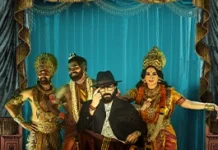Celebrating Shiva’s Grace: From Anji to Akhanda, from Baahubali to KhalejaThe powerful imagery and symbolism of Lord Shiva carries a special meaning for crores of devotees. In Telugu cinema, Shiva has been a beautiful force in different ways. On this auspicious Maha Shivaratri, we take you through some of the major instances.
In Chiranjeevi’s Anji, Lord Shiva’s influence is woven into the very fabric of the story. Shiva’s divine energy acts as a guiding force. The film visually blends divinity with adventure.
Balakrishna’s Akhanda presents a powerful depiction of Shiva. The protagonist, Akhanda, is a fierce protector of dharma. The film’s narrative is steeped in Shiva’s symbolism, Boyapati Sreenu-style.
Nagarjuna’s Damarukam is about Shiva’s wrath, which is invoked to combat a demonic entity threatening harmony. Subtly, the film showcased the God’s ability to restore balance to the universe.
In Mahesh Babu‘s Khaleja, Shiva’s presence is more subtle yet equally potent. The protagonist, Raju, is believed to be the saviour. The song Sada Siva, written by Ramajogayya Sastry, is considered a devotional classic.
Beyond direct intervention, Telugu cinema has also utilized Shiva’s imagery to create breathtaking action sequences. Prabhas’ Baahubali 2 features a well-choreographed sequence where the protagonist literally lifts a gigantic Lingam and ensures Nithya Abhishekam, much to his mother’s delight.
In Ram Pothineni’s Double iSmart, for example, the use of tridents, third eye imagery, and the fierce energy of Shiva’s tandava dance is superb.

Watch Telugu Online Here








































